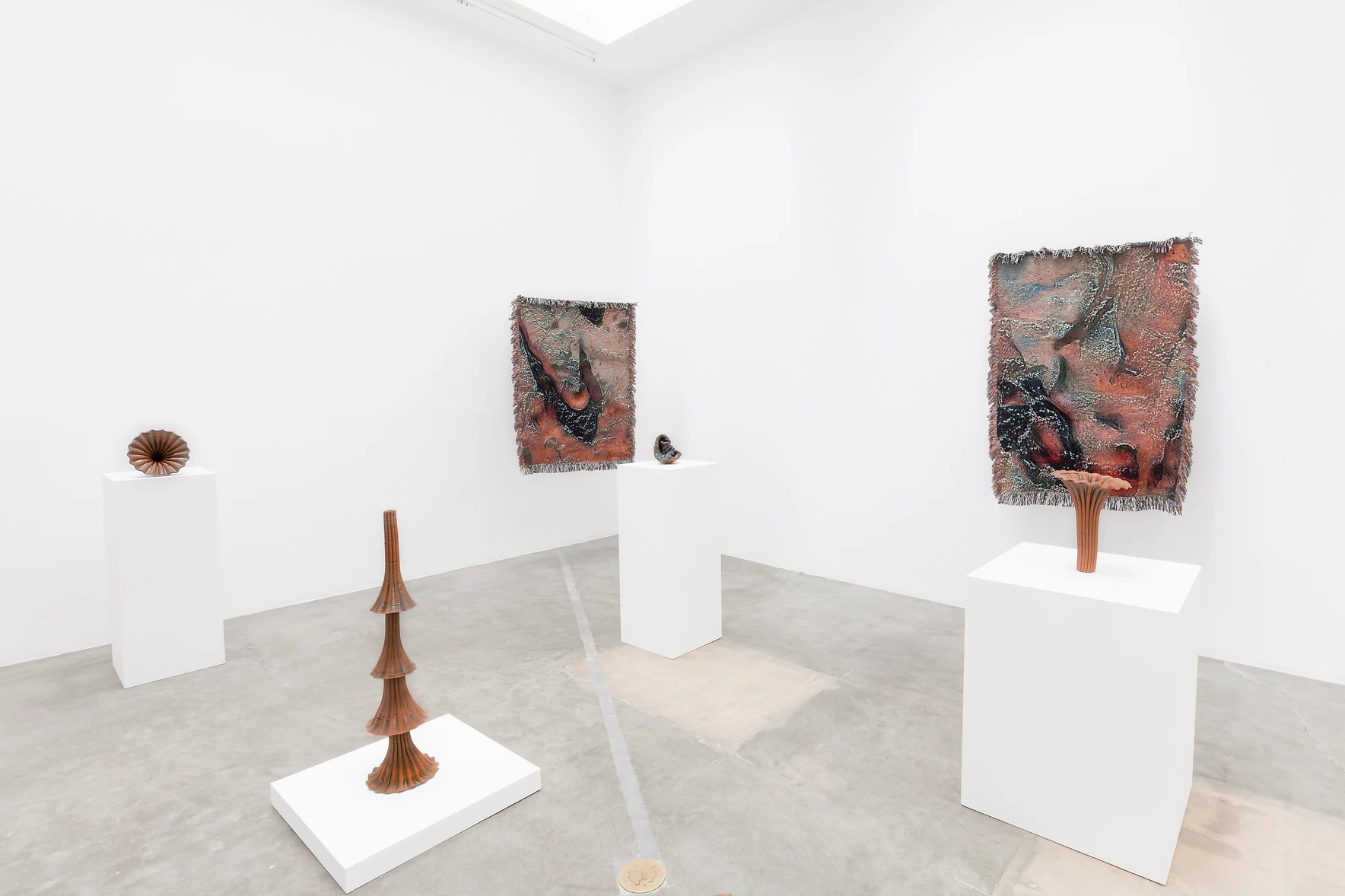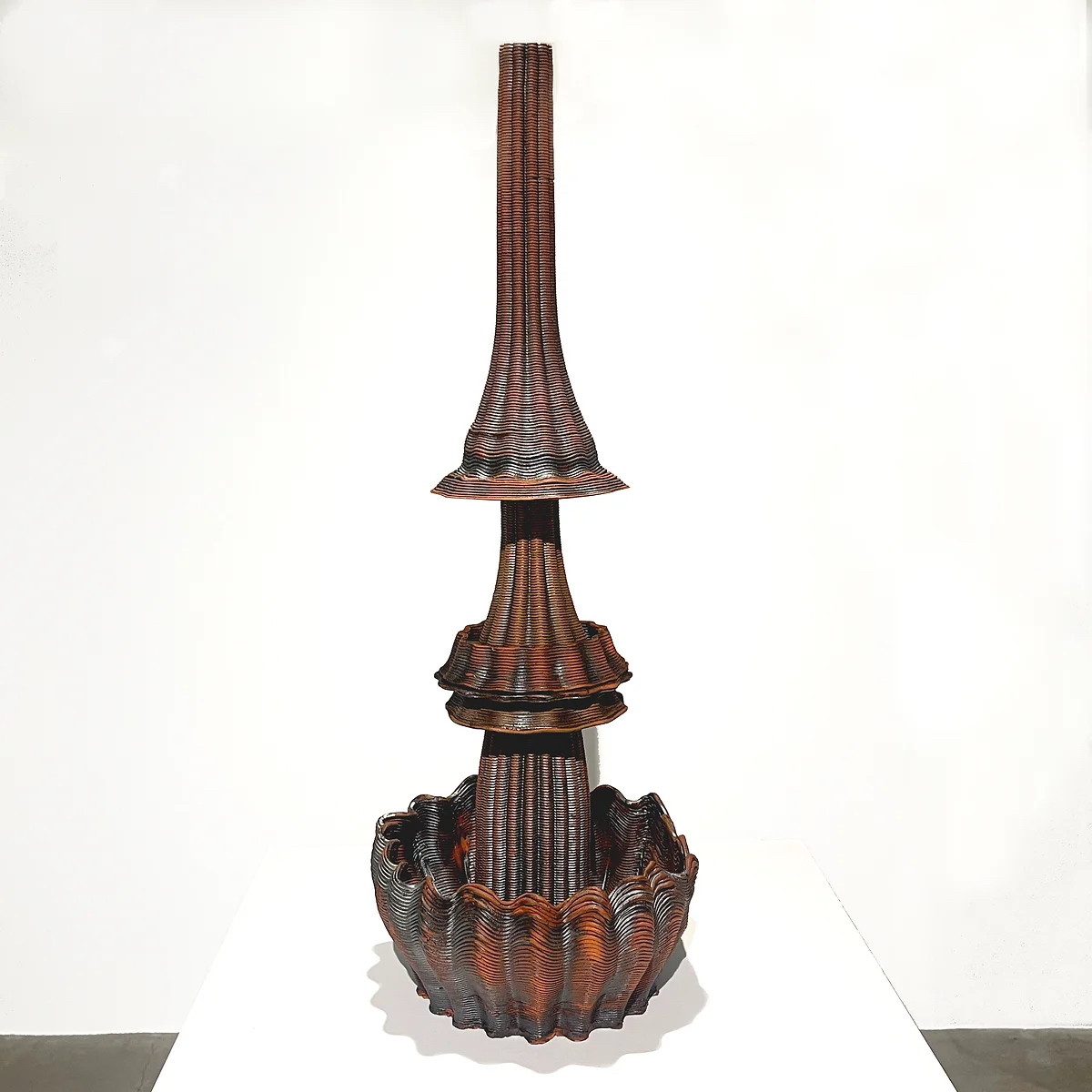An Artist Combines Indigenous Textiles With Modern Tech
6:51 minutes

When multidisciplinary artist Sarah Rosalena looks at a loom, she thinks about computer programming. “It’s an extension of your body, being an algorithm,” she says.
Rosalena, a Wixárika descendant and assistant professor of art at the University of California Santa Barbara, combines traditional Indigenous craft—weaving, beadmaking, pottery—with new technologies like AI, data visualization, and 3D-printing. And she also works with scientists to make these otherworldly creations come to life. She involved researchers at the NASA Jet Propulsion Lab to make 3D-printed pottery with simulated Martian clay. And she collaborated with the Mount Wilson Observatory to produce intricately beaded tapestries based on early-1900s glass plates captured by the observatory’s telescope, which women mathematicians used to make astronomical calculations.

And that’s also a big focus for Rosalena: spotlighting the overlooked contributions women made to computer science and connecting it to how textiles are traditionally thought of as a woman-based craft. When she first started making this kind of art, Rosalena learned that the Jacquard loom—a textile advancement in the 1800s that operated on a binary punch card system which allowed for mass production of intricate designs—inspired computer science pioneer Ada Lovelace when she was developing the first computer program. “[They] have this looped history,” she says. “And when I weave or do beadwork, it’s also recalling that relationship.”
But for Rosalena, there is tension and anxiety in her decision to combine new and ancient mediums. “We’re at this point of the technological frontier and that’s actually terrifying for a lot of people, especially for people from my background and my Wixárika background,” she says. “It’s progress for some, but it’s not for all.”
Part of Rosalena’s work is anticipating future forms of colonization, especially amid rapid change in our planet’s climate and the rise of AI. “What happens when we bring traditional craft or Indigenous techniques with emerging technology to think about current issues that we are facing? Digital technologies are always chasing after ways that we could simulate our reality, which also produces this way that we could re-envision our reality,” she says.
SciFri producer and host of our podcast Universe Of Art D. Peterschmidt sat down with Rosalena to talk about how she approaches her work, why she collaborates with scientists, and how she hopes her art makes people consider today’s technological advancements through an Indigenous lens.
You can see Rosalena’s work in an exhibition Sarah Rosalena: In All Directions at the Columbus Museum Of Art at The Pizzuti in Columbus, Ohio, until February 4.
Sarah Rosalena is an interdisciplinary artist and an assistant professor of art at the University of California, Santa Barbara in Los Angeles, California.
IRA FLATOW: The patterns woven in textiles can tell a powerful story, and Sarah Rosalena knows this well. She’s a multidisciplinary artist who blends ancient mediums and Indigenous knowledge with data and new technology. She’s collaborated with NASA JPL, the LA County Museum of Art Tech Lab. And her work is currently featured at the Columbus Museum of Art, in Columbus, Ohio until February 4th.
SciFri producer and host of our podcast Universe of Art, D Peterschmidt, sat down with Rosalena to talk about her collaborations with scientists, space colonization, and how she views technological advancements through an Indigenous lens. Here’s D.
D PETERSCHMIDT: When Sarah Rosalena thinks about the loom, she thinks about computer programming.
SARAH ROSALENA: It’s an extension of your body being an algorithm.
D PETERSCHMIDT: Ada Lovelace, who wrote the first algorithm design for a computer, said she’d been inspired by the Jacquard loom developed in the 1800s, which used a binary punch card to mass produce intricate textile designs. And that approach, blending old mediums with new tech, sums up Rosalena’s approach to her own art. She’s an assistant professor of art at UC Santa Barbara based in LA. And she’s of Wixárika descent– Indigenous people native to what is now parts of Mexico and the Southwestern United States.
She works in these old art forms– textiles and pottery– but uses AI and Data Visualization as part of the creative process. It’s a way to process her feelings about how modern society is progressing.
SARAH ROSALENA: We’re at this point of the technological frontier. And that’s absolutely terrifying for a lot of people, especially for people from my background and my Wixárika background. We’re living in the time of climate change, dispossession, the rise of AI. And I’m always interested in anticipating future forms of colonization because it’s progress for some but it’s not for all.
D PETERSCHMIDT: Rosalena, who’s a fourth generation Wixárika weaver, was taught traditional Indigenous textile work by her grandmother.
SARAH ROSALENA: It’s something that really made her feel sane. I remember she always encouraged me to weave for mental health, but it was also good for exercising your mind.
D PETERSCHMIDT: After college, Rosalena found herself in the Bay Area, around the time of the tech boom of the late aughts, and learned to code.
SARAH ROSALENA: And there was a lot of interesting people that I met at that time were very similar to me. A lot of BIPOC people working in code. But at the same time, tech startups really started to rise and displacing a lot of the people that I used to enjoy hanging out with.
D PETERSCHMIDT: Frustrated she moved back to LA and rediscovered her love for textile work.
SARAH ROSALENA: I saw so many relationships between the code that I was writing and actual designs that I was weaving that they couldn’t help but intersect. It was very much like an aha moment. What happens when we bring traditional craft or Indigenous techniques with emerging technology to think about current issues that we are facing. Digital technologies are always chasing after ways that we could simulate our reality, which also produces this way that we can re-envision our reality.
D PETERSCHMIDT: And Rosalena doesn’t just re-envision reality with herself. She often collaborates with scientists to make her art.
SARAH ROSALENA: It’s a big role as an artist to work with scientists and engineers because we see the world differently. And there’s a lot of value in that.
D PETERSCHMIDT: One of those collaborations was with NASA JPL in Pasadena. And Rosalena learned that they had a mutual interest– clay. The Space Agency was experimenting with simulated Martian soil, also called regolith, to potentially construct livable human habitats on the Red Planet without having to transport heavy building materials all the way from Earth.
SARAH ROSALENA: So they were doing a lot of research on regolith simulant and clay to actually build some of the first settlements out of basically Adobe, which made me giggle. Because, again, it’s like how much space colonization is dependent on Indigenous knowledge even on another planet.
D PETERSCHMIDT: Rosalena also teaches coil pot construction at UC Santa Barbara, an Indigenous method of making ceramics that’s one of the oldest in the world. Coil pots look like what they sound like. Coils of clay are layered on top of each other until you get your vessel. And she wanted to update that with a techy Martian twist. With the help of NASA engineers, she was able to make her own version of Martian clay based off soil analysis from JPL’s rovers like Curiosity.
She modeled the vessels in the computer and then 3D printed them using her Martian Adobe. The resulting sculptures look both futuristic and ancient. The ribbed, rust-tinged ceramics take a few shapes– the mouth of a black hole, a long cylinder that looks like it’s eating itself, a vaguely spherical shape that appears as though it was crushed by the forces of gravity. And Rosalena’s passion for pottery even rubbed off on JPL’s engineers.
SARAH ROSALENA: I actually made a lot of friends. Some of them got into ceramics at the time, which was also really interesting to have Martian cartographers who were guiding the rovers suddenly be interested in actually the chemical compounds of clay. And we would talk for hours on end on making clay, finding native clay in Los Angeles.
D PETERSCHMIDT: Located just a few miles away from JPL is the Mount Wilson Observatory, which Rosalena has also partnered with. It was an important observatory in the early 1900s. Edwin Hubble used the telescope to prove that the universe is expanding. But discoveries like that couldn’t have been made without the help of female computers. Women who analyzed the raw data from the telescope and performed complex math that made those discoveries possible.
SARAH ROSALENA: But when I got there, I realized that female computers were mostly cropped and edited out of the history of that observatory.
D PETERSCHMIDT: Back then, the images from the telescope were exposed onto glass plates, which the female computers use to make their calculations.
SARAH ROSALENA: And I found textile was a unique way to approach it because it is a feminist or a female-based craft.
D PETERSCHMIDT: So to shed light on these women’s work, Rosalena took those plates and digitized them into a lower resolution where each pixel would become a bead on a tapestry, which she then assembled by hand. But not all of these tapestries are neat rectangles, some of them distort and fray as the beads progress downwards looking like a starry cosmic jellyfish.
Rosalena hopes her art doesn’t just serve as a form of protest, but also provides an alternative way of interpreting the world around us, one that places a much larger emphasis on Indigenous knowledge.
SARAH ROSALENA: It is very important because a lot of the current crises that we’re facing are a crisis of humanity in many ways. And I feel like artists really shine that light, and also can see the world differently than what a scientist or engineer does. And we can learn quite a bit from one another.
D PETERSCHMIDT: For Science Friday, I’m D Peterschmidt.
IRA FLATOW: Thanks, D. You can check out photos of Rosalena’s work at sciencefriday.com/textileart. And like I said before, her art is on view at the Columbus Museum of Art in Columbus, Ohio until February 4th.
Copyright © 2023 Science Friday Initiative. All rights reserved. Science Friday transcripts are produced on a tight deadline by 3Play Media. Fidelity to the original aired/published audio or video file might vary, and text might be updated or amended in the future. For the authoritative record of Science Friday’s programming, please visit the original aired/published recording. For terms of use and more information, visit our policies pages at http://www.sciencefriday.com/about/policies/
Dee Peterschmidt is a producer, host of the podcast Universe of Art, and composes music for Science Friday’s podcasts. Their D&D character is a clumsy bard named Chip Chap Chopman.
Ira Flatow is the founder and host of Science Friday. His green thumb has revived many an office plant at death’s door.